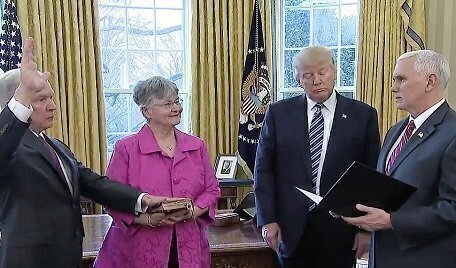The apparent conflict between President Donald Trump and his Attorney General, Jeff Sessions, has led to speculation that Sessions could be leaving his position soon. Such an action would be unprecedented if Sessions were actually fired, but there have been several occasions where past Attorneys General left office under pressure.
 Technically, no sitting President has ever fired an Attorney General they nominated to office with Senate approval. But President Trump clearly has the power to remove Sessions, based on the Constitution and past legal decisions. And most importantly, he can ask for his resignation.
Technically, no sitting President has ever fired an Attorney General they nominated to office with Senate approval. But President Trump clearly has the power to remove Sessions, based on the Constitution and past legal decisions. And most importantly, he can ask for his resignation.
In the Constitution’s Article II, Section 2, the President has the ability to fill executive offices under the Appointments Clause, which reads that “he shall have Power, by and with the Advice and Consent of the Senate, to make Treaties, provided two thirds of the Senators present concur; and he shall nominate, and by and with the Advice and Consent of the Senate, shall appoint Ambassadors, other public Ministers and Consuls, Judges of the supreme Court, and all other Officers of the United States.”
In 1789, James Madison made it clear that he thought the President also should have the ability to fire Cabinet officials that he nominated to office. Madison added language to a bill that created the Department of Foreign Affairs that allowed the President to fire the Secretary of State, if needed.
Congress always hasn’t agreed with that concept. The Tenure of Office Act, which led to President Andrew Johnson’s impeachment trial in 1868, required the President to get Senate approval before removing a Cabinet official. That act was later repealed by Congress.
And in 1926, Supreme Court Chief Justice William Howard Taft said in Myers v. United States that “the President has the exclusive authority to remove executive branch officials.” Subsequent court decisions narrowed this power somewhat for certain officials outside of the Cabinet. But few people doubt today that a President can remove a Cabinet officer.
The most dramatic example of Cabinet firings in recent times was President Jimmy Carter’s request in July 1979 that his entire Cabinet offer their voluntary resignations after a dramatic television speech about the economy. Five officials accepted Carter’s offer. But Carter also asked his attorney general, Griffin Bell, to propose legislation that would limit a President’s ability to fire an Attorney General. Bell refused, citing precedent that such legislation would be unconstitutional.
President Lyndon Johnson’s conflict with Secretary of Defense Robert McNamara during the Vietnam War led to McNamara’s resignation in 1968. McNamara later said he was unsure if Johnson fired him during their conflict.
As for Attorneys General, President Harry Truman asked for and received the resignation of his Attorney General, Howard McGrath, in 1952. McGrath, Truman’s former campaign manager, had fired a special investigator looking into problems at the Justice Department without consulting Truman.
Other Attorneys General have left office amid controversies. In 2007, Alberto Gonzalez resigned from the Bush administration after the alleged firing of U.S. attorneys for political reasons.
Attorney General John Crittenden quit President John Tyler’s cabinet in 1841 in a conflict over Tyler’s refusal to pursue a pro-Whig political agenda. Another Attorney General, Henry Stanbery, quit in 1868 to serve as Andrew Johnson’s impeachment trial attorney.
President Ulysses Grant also called for the resignation of Ebenezer Hoar in 1870 to bring in an Attorney General with southern roots, Amos Akerman. But then Grant requested Akerman’s resignation 13 months later. Both men complied with Grant’s request.
Harry M. Daugherty, President Warren Harding’s Attorney General, resigned in the wake of the Teapot Dome scandal at the request of President Calvin Coolidge. And in 1974, Elliot Richardson resigned when asked by President Richard Nixon to fire Watergate special prosecutor Archibald Cox. Richardson refused to fire Cox.
Scott Bomboy is the editor in chief of the National Constitution Center.







